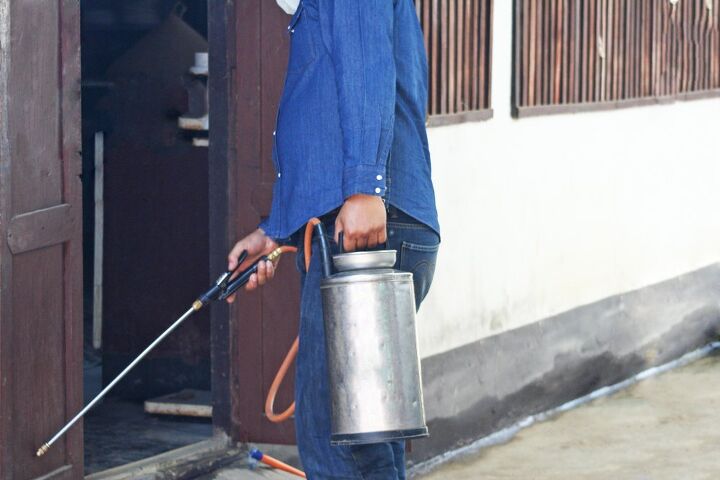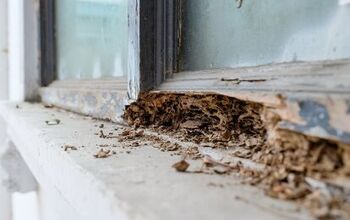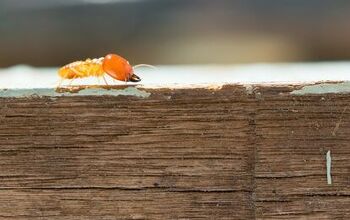How Much Does Termite Treatment Cost?

Termites are the worst pest that you can come across in your home, and treatment is a must. It can be overwhelming when you see termites, or even worse, the damage they caused. Builder-owners that stumble across termites must call an exterminator and pay for treatment.
The average termite treatment cost is $600, and you’ll need to spend another $100 for termite inspection. Heat treatment costs $1.50 per linear foot or $3,750 for a 3,000 square foot house. Termiticide treatment averages $1,600, but you’ll spend up to $4,800 if you have to tent your house for 3 days.
Homeowners that suffer severe termite damage can spend up to $3,000 or more in repairs. That is why testing, which costs roughly $100, and treatment, are necessary. Follow along, and we’ll take a close look at what you should expect to pay for termite treatment.
Do You Need Pest Control Services?
Get free, zero-commitment quotes from pro contractors near you.

How Much Does Termite Treatment Cost?
It can cost between $200 and $2,500 or more for termite treatment. There are many factors, such as method and chemicals, that determine termite treatment cost. Your average homeowner pays $600-$700, but the exterminator that you choose, or the severity of the problem can increase the cost.
Before you can get termite treatment, you need to have your home inspected for the pests.
How Much Does Termite Inspection Cost?
Termite inspection costs between $50 and $150, but many homeowners pay $75-$100. You can spend as much as $400 for termite inspection for large houses or properties. The first step of getting termite treatment is an inspection, so it is a necessary cost factor.
You can sidestep termite inspection costs if you invest in a termite protection plan. A termite protection plan includes inspections and treatments and costs $1,200. You can also avoid inspection costs if your local exterminator performs free inspections.
It is less common, but some exterminators do perform free termite inspections. However, if you are selling your house, you must pay for a termite inspection on behalf of the buyer or lender.
Termite Heat Treatment Cost
It costs between $8 and $12 per linear foot for termite heat treatment. Heat treatment can also be priced at $1-$1.50 per square foot. Heat treatment is quite intense, so you’ll want to clear your house of any valuable items sensitive to heat.
The blast of heat equals 120 degrees Fahrenheit, and the temperature is sustained. During the 33 minutes of intense heat, the termites all die and are not your problem. If your house is 3,000 square feet, it could cost between $3,000 and $4,500, but it could cost less.
Termiticide Treatment Cost
Termiticide is a powerful insecticide that has lasting effects for 5 years. Many homeowners pay $10 per linear foot for termiticide treatment, but you can pay less at $5 per linear foot.
You could pay between $1,000 and $2,000 for termiticide treatment for a 200 linear foot home. The key to termiticide is that it actually kills the termites. That means that you don’t have to worry about them coming back, provided it was professionally and properly applied.
Not all treatments kill termites like termiticide, and others simply make them go away. That is not as effective, because once the treatment wears off, they can come back. Some termiticides, such as Termidor, are proven to be 100% effective at killing termites.
Termite Tenting Cost
Termite fumigation and tenting seems drastic, and it is, but it works. Tenting can cost up to $5 per square foot, but it can be as little as $1 per square foot. The total cost is determined by how large the house is and the severity of the termite infestation.
Essentially, tenting creates an airtight environment where the termites cannot escape. While in the tented house, the termites breathe in the harmful fumigation and eventually die. After 3 days, the exterminators will check to see that the termites are dead.
An average house is around 1,600 square feet and tenting and fumigating it costs $1,600-$8,000. That cost will generally be closer to the lower end, but extreme cases get pricey.
Termite Baiting Treatment
Another popular method of termite treatment is baiting. Baiting is where an exterminator sets up numerous baiting stations for the termites throughout the house. Each baiting station contains poison, and the hope is that termites will find their way to them.
It can cost up to $3,000 for professional baiting treatment. The cost is mostly determined by the size of your house. How many baiting stations you need is based on size, and you need many of them for large houses.
With that said, if your house is 1,200-1,600 square feet, you’ll spend closer to $1,500-$2,000. Talk to your exterminator about what kind of baiting system they are using, as some, such as non-liquid bait, are less maintenance.
Termite Bait System Cost
Besides hiring a pro for termite baiting, you can buy a bait system and do it yourself. However, it should be noted that termite bait systems are not always as effective as using a professional. You can buy termite bait systems for between $140 and $250.
Termite bait systems work similarly to ant traps. The termites enter the bait system, eat poison, and bring it back to their nest. If the system worked, then that termite will unknowingly spread the poison and kill the remaining termites.
It is only worth using termite bait systems on your own for less severe cases. That is because you must set them up every 20 feet for severe cases, and that can cost you a fortune. Big houses are better off with an exterminator for baiting treatment.
Micro Termite Treatment
Not all termite outbreaks are that severe, and if not, count yourself lucky. Small termite outbreak treatment is much cheaper because of the fact that you don’t need chemicals, in most cases. Some builder-owners choose to go DIY and use bait systems for small cases, but micro treatments are a better option.
Despite being a small treatment, it still costs $1,000. It could cost more or less for bigger or smaller spaces, but it is still cheap. Heat is the main method used for micro treatment, and chemicals are avoided altogether. Micro treatment is effective because it can both kill termites and prevent further spread.
| Termite Treatment | Cost |
| Heat Treatment | $3,000-$4,500 |
| Termiticide | $1,000-$2,000 |
| Tenting & Fumigation | $1,600-$8,000 |
| Baiting Treatment | $1,500-$3,000 |
| Bait System | $140-$250 (each) |
| Micro Treatment | $1,000+ |
Termites In Dry Wood
Termites are attracted to different types of wood, but they’ll settle for anything. Once common wood that termites infest is Drywood. You typically only encounter dry wood termites in western states in America but can be found as far south as New Orleans.
As termites chew dry wood, it causes serious and costly damage. Treating dry wood for termites involves creating a hole to apply termiticide or another chemical through. It can cost as little as $400, or as much as $2,000 if the termites are throughout the house.
If the termites caused serious damage to your dry wood, you need to replace it. Replacing dry wood costs up to $10 per linear foot. However, if the infestation is severe and fumigation is required, it could cost $3,000, or even more.
Damp Wood Termite Treatment
Termites also infest damp wood, and they can easily destroy it. As the name suggests, damp wood is somewhat damp, and it can attract termites. If you have damp wood that is in any state of decay, it will look attractive to termites.
Depending on the severity of the infestation, you could spend well over $2,000 on damp wood termite treatment. However, micro treatment could cost between $500 and $1,000 if the termites are confined to a small area.
Chemical treatments are quite common for damp wood termites. If you have structural damp wood and suspect termites, call an exterminator immediately.
Subterranean Termite Damage
Termites are so pesky and awful that they can even cause damage beneath your home. Certain conditions, such as moisture, help attract subterranean termites, and they can wreak havoc on a basement.
Luckily, subterranean termites seem to often stay in one area, if the space is confined enough, that is. If you are lucky enough to have your termites stay in once space, you could spend $500 on treatment. However, the main concern is that they will spread to the rest of your house.
To prevent further damage and spread, make sure that the treatment plan involves prevention. A termiticide treatment is great for subterranean termites due to the longevity it offers.
Cost To Repair Termite Damage
Termites cause up to $30 billion in damages in America alone. Sadly, the average homeowner has to spend $3,000 in repairing the damage done by termites. Of course, it can cost significantly more or less based on the severity of the damage, and how widespread it is.
You could spend up to $2,000 on replacing insulation damaged by termites. Some of the worst, most costly damage comes from crawlspaces, and basements, for big infestations. If your termites managed to chew through a decent amount of drywall, you could spend between $450 and $1,000.
Cost To Install Termite Barrier
A termite barrier is used to keep subterranean termites from causing a problem. Exterminators essentially just pour termiticide into the soil. Subterranean termites love soil, and a termiticide termite barrier kills them.
It costs an average of $3,000 for a termiticide termite barrier for subterranean termites. That is considered to be the best method of disposing of subterranean termites.
Heat Treatment vs. Fumigation For Termites
There is some debate as to what is better: heat treatment, or fumigation. The fact is, both methods are highly effective at killing termites, but each is better for different uses.
For example, if your termites are not located throughout the entire house, fumigation would be too much. You can still fumigate if you have a small infestation but filling an entire house with chemicals when termites are confined to one are is a bit of a risk.
Infestations that are localized are best treated by heat. Otherwise, your exterminator will likely recommend fumigation if there are signs of termite activity throughout the house. Ultimately, you should listen to the recommendation of the exterminator.
Signs Of Termites
You can usually tell that you have termites long before a termite inspection. It is never a good sign when you catch termites but catching them early on is vital. Homeowners that know what signs to look for can catch termites early and save a fortune on repairs.
- Faint clicking sound
- Dead termites in the house
- Termite wings on the ground
- Droppings (frass)
- Warped doors and windows
- Spots on walls similar to water damage
If you hear a faint clicking sound with no explanation, it could be termites. That is the main sound that they make but finding a dead one is proof positive you have a termite problem. You may not find a full termite, but if you seem disembodied wings, they could belong to a termite.
Another key sign to look out for is termite droppings. Termite droppings are known as frass, and it has a powder consistency that is recognizable. If your windows and doors are warping, or there are water spots on the wall with no water in sight, it could be termites.
Related Questions
Is termiticide safe?
Yes, termiticide is safe, and that is why it is widely used in extermination. No matter what it’s for, insecticides are not good for humans to breathe. Professional exterminators take precautions and use the termiticide safely and without contaminating your home.
Is preventative termite treatment necessary?
It may not be entirely necessary, but it is well worth it and a great investment. Exterminator services generally suggest that yearly termite treatment is the only way to prevent termites. Many termite prevention treatments can last for up to 5 years of not worrying about termites.
Who pays for termite inspection?
If you are in the process of buying a home, the responsibility of termite inspection is up to the seller. Many buyers use a lender when purchasing a home, and lenders require a termite inspection. You could spend roughly $75-$100, or slightly more, for termite inspection.
What is the safest termite treatment?
The safest termite treatment is baiting systems. Baiting systems are so safe because it involves an exceedingly small amount of chemicals toxic to termites, and there’s little risk of human transmission. In other words, you are unlikely to be exposed to the chemical that the termite ingests and brings to its colony.
Do termites come back after treatment?
Unfortunately, termites can come back after treatment, but it does not always happen. Some treatments, such as termiticide, have long-lasting effects, but they can still come back. In fact, if they did damage the first time, even more may come the second, and that’s why yearly treatment is encouraged.
Do termites leave sawdust?
If you see a sawdust-like material, it is in fact frass, not sawdust. Frass, or termite droppings, holds the appearance of sawdust and can easily be mistaken for it. You should look up images of frass so that you can distinguish the difference, because it is a telltale sign of a termite infestation.
Do You Need Pest Control Services?
Get free, zero-commitment quotes from pro contractors near you.

Summing It Up
Termite treatment costs $200-$2,500 for most cases but can cost as much as $8,000 for severe cases. Widespread termite infestations are best treated by tenting and fumigation, which starts at $1,600. Termiticide treatments are quite popular and used by many exterminators because it works well can last up to 5 years.
Exterminators recommend that you get your home treated for termites every year. Choosing a prevention plan for $1,200 is the best way to do that, and it is worth avoiding damage. Keep an eye out for termite wings, frass (termite droppings), dead termites, rotting or decayed wood, and warped doors and windows.
Termite treatment is a matter of saving yourself thousands of dollars down the line. If you can catch termites early, you can keep your treatment to $400-$600, or even less. Call an exterminator for an inspection, and follow up with treatment.

Nick Durante is a professional writer with a primary focus on home improvement. When he is not writing about home improvement or taking on projects around the house, he likes to read and create art. He is always looking towards the newest trends in home improvement.
More by Nick Durante














![How Much Do Ant Exterminators Cost? [2022 Rates]](https://cdn-fastly.upgradedhome.com/media/2023/07/31/9092734/how-much-do-ant-exterminators-cost-2022-rates.jpg?size=350x220)








![Standard Dining Room Table Dimensions [for 4, 6, 8, 10 and 12 People]](https://cdn-fastly.upgradedhome.com/media/2023/07/31/9074335/standard-dining-room-table-dimensions-for-4-6-8-10-and-12-people.jpg?size=350x220)



